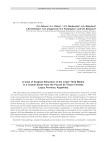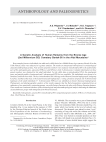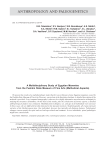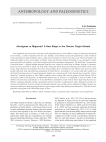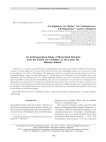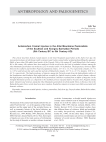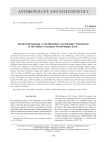Anthropology and paleogenetics. Рубрика в журнале - Archaeology, Ethnology & Anthropology of Eurasia
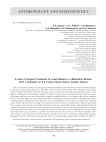
Статья научная
Here, we present the earliest case of surgical treatment of mandibular permanent molars known in Northern Eurasia. It concerns an aged woman buried at a Mesolithic cemetery on the Yuzhny Oleniy Ostrov (Island) in Lake Onega, southern Karelia, 8250–8050 cal BP. Our objective was to reconstruct the technology of surgical intervention, and to diagnose and describe the underlying condition. To do this, we carried out an examination of teeth and bone tissues of the upper and lower jaws and a traceological analysis of identified lesions. As we found, in the last few months of her life, the woman underwent several dental operations, including the extraction of the lower left third molar and, in a stepwise fashion, of fragments of the distal part of crown and lingual part of the distal root of the lower right first molar. The first operation was successful—the woman survived for at least two months after it had been performed. The second operation was also successfully performed at least two months before death, likely immediately after the trauma. The mesial part of the crown was removed just before death. No ancient cases where fragments of an injured tooth were removed are known to us. The removal of the lower third molar can be compared only with the earliest previously known case, described in a sample from the Pucará de Tilcara fortress in Northern Argentina (15th–16th centuries AD). Indications for surgery partly coincide in both cases, and include complications of apical periodontitis and the development of osteomyelitis. However, the technology of surgery and its logistics are different.
Бесплатно
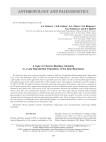
A case of chronic maxillary sinusitis in a late Neanderthal population of the Altai mountains
Статья научная
We describe a likely case of chronic maxillary sinusitis (CMS) in a Neanderthal skeletal sample from Chagyrskaya Cave, in the Altai Mountains. Signs of CMS were recorded in the Chagyrskaya 57 specimen, which is a fragment of a left maxilla. Alveoli of the upper fi rst molar are partially preserved, and so are the second and third upper molars, with adjacent parts of the walls, and the fl oor of the maxillary sinus. The fragment was found in layer 6b, dating to 53,100–51,100 BP. We analyze the factors that had caused the development of the disease, and assess its etiology. In the 3D-model, generated by computed microtomography, and in the original specimen, porotic changes were registered, situated at the fracture line of the alveoli of M1, lost post-mortem, and near the vestibular roots of both preserved molars. Also, there were isolated bone spicules, 1.0–2.6 mm in size. These signs indicate incipient CMS, evidently caused by chronic periodontal disease combined with a deep alveolar recess of the maxillary sinus. As the periodontal gap expanded, several small nutrient foramina, piercing the bottom of the sinus, merged. As a result, several oro-antral channels formed, whereupon the infection spread into the maxillary sinus. Since the deep alveolar recess is observed in the vast majority of Neanderthal crania with published images or reconstructed maxillary cavities, it can be assumed that Neanderthals were predisposed to odontogenic CMS.
Бесплатно

A digital X-ray analysis of Middle Bronze Age skeletal samples from the Baraba forest-steppe
Статья
We present the results of a comparative analysis of skeletal and dental pathologies in Middle Bronze Age individuals buried at Late Krotovo and Andronovo (Fedorovka) cemeteries in southwestern Siberia. This was the period when the Andronovo steppe tradition in Northern and Central Asia expanded in various directions, including the foreststeppe. Growth arrest lines on tibiae (Harris lines) and dental pathologies (enamel hypoplasia and caries) were recorded. To evaluate developmental anomalies in the bone tissue, digital X-ray analysis was used. The principal sample includes representatives of various sex and age groups buried at the largest cemetery in the region, Tartas-1 (Baraba forest-steppe). Harris lines and enamel hypoplasia result from a broad range of factors such as infections, occasional malnutrition, traumas, vitamin defi ciencies, etc. Caries is caused by a high amount of carbohydrates in the diet, accompanied by low standards of oral hygiene. These pathologies occur at different ages: Harris lines and enamel hypoplasia evidence adverse factors during infancy and adolescence, whereas caries is typical of adulthood. Late Krotovo and Andronovo groups differ in terms of occurrence and combination of pathologies. Enamel hypoplasia is less frequent in the Andronovo sample, indicating a lesser stress level in children. Harris lines are less frequent in the Late Krotovo group, suggestive of lower stress level during adolescence. These differences may be tentatively attributed to various models of subsistence and cultural adaptation.
Бесплатно
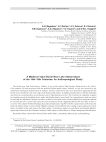
A medieval Yakut burial near lake Atlasovskoye of the 14th–15th centuries: an anthropological study
Статья научная
The burial near Lake Atlasovskoye, Yakutia, is one of the earliest Yakut burials, dating back to the 14th or 15th centuries and associated with the medieval Kulun-Atakh culture. Initially, its age was assessed by the comparative typological method based on artifacts, and later а radiocarbon estimate was generated, suggesting that the burial dates to the early stage of the Kulun-Atakh culture. Its highly unusual feature is that the individual was buried in a seated position – an exceptional case in the Yakut funerary practice. The cranium was completely wrapped in a bandage sewn from birchbark sheets, under which lethal injuries were found. Our comprehensive study was aimed at assessing the individual's lifestyle and cause of death. Postcranial bones revealed pathologal symptoms unusual for an early age (20–25) and caused by excessive physical strain, suggesting that the man was either a slave or a warrior. The complex birchbark bandage may indicate high status. Together with the seated position of the body, this makes the military status even more likely. Multiple traumatic lesions infl icted with a cutting tool indicate the violent nature of confl icts at the early stage of the Yakut culture. Craniometruic analysis reveals Buryat and Mongol affi nities, supporting epic evidence relating to Yakut origins, in which Buryat or Mongol immigrants had taken part.
Бесплатно
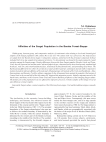
Affinities of the Sargat population in the Baraba forest-steppe
Статья научная
Within-group, between-group, and comparative analysis of craniometric data relating to local and chronological samples of the Sargat population (5th century BC to late 3rd / 4th century AD) was carried out. The study focuses on sample from the Baraba forest-steppe. Comparative analysis, performed with the principal component method, included Early Iron Age samples from adjacent territories. No discontinuity was found in the spatio-temporal cranial variation among the Sargat groups. Despite differences between the three Sargat samples (Baraba, Irtysh, and Trans-Ural), they all represent one and the same Caucasoid physical type, characterized by meso-brachycrany, medium-high braincase, wide low, and somewhat flattened face, moderately inclined frontal bone, and protruding nasal bones. The Baraba group differs from two others by a wider face, larger pyriform aperture, and largest dacryal width. Comparative statistical analysis indicates affinities of the male part of Sargat groups with nomads of the Urals and Kazakhstan—Saka, Sauromatians, and Sarmats. Possibly, military campaigns by the Achaemenid state against the nomadic tribal unions of Central Asia in the second half of the 6th century BC triggered the migration process. Initially, migrants moved to the Irtysh basin, and thence to the western (Trans-Ural) and eastern (Baraba) peripheries of the emerging Sargat culture. The female part of the population was less affected by migratory processes. Female samples of the Sargat reveal an autochthonous cranial complex.
Бесплатно
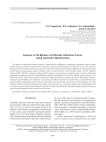
Analysis of 3D-models of artificially deformed crania, using geometric morphometry
Статья научная
The study of artificially deformed crania is complicated by difficulties in analyzing curvilinear shapes without reliable reference points for measurement. Methods of geometric morphometrics (GM) help to solve this problem. We generated 3D-models of deformed crania (26 male and 19 female) from burials of different chronological periods of the Okunev archaeological culture (Verkhniy Askiz I, Uybat III and V, Uybat-Charkov, Itkol I and II), Southern Siberia (2600–1700 BC). Using the Landmark IDAV software, each model was transformed into a set of six traditional craniometric landmarks and 450 semi-landmarks regularly distributed over the entire surface of the braincase. For further processing with the Procrustes and principal component analysis, functions of several R-packages (Morpho, Geomorph, and Arothron) were employed. Crania from early Okunev burials were found to have a small deformed area around lambda, spanning the posterior parts of parietal bones and the upper part of the occipital squama. In crania from later Okunev burials, the deformation extends on the parietal area, causing the reduction of cranial height owing to a lesser curvature of the parietal segment. The lateral walls of the braincase, the frontal squama, and the lower part of the occipital squama in such crania are more convex.
Бесплатно
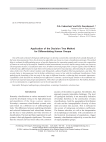
Application of the decision tree method for differentiating human groups
Статья научная
One of the tasks of modern biological anthropology is to develop a system that could objectively classify humanity on the basis of measurements. Here, the decision tree algorithm was chosen to create a classification of groups. The method helps to evaluate the differentiating power of specific dimensions for separating samples and to assess the composition of clusters at each step of the analysis. Standard cranial measurements were used, and the entropy index was chosen as a heterogeneity measure. Classification units were 39 ethno-territorial groups from 13 major regions of the Old World. At the first step, differentiation is made between broad-faced and narrow-faced groups, demonstrating the classificatory value of this trait. The first cluster includes only Mongoloids, admixed Southern Siberian populations, and Ainu. The second cluster is heterogeneous, but its further subdivision is more in line with the traditional classification. Traits underlying the branching of the tree may be the same in different branches, evidencing their taxonomic importance. Capabilities of the decision tree method proved sufficient to construct a system largely similar to the traditional one. Certain traits separate large groups of populations, while others are efficient at the regional level. The method, therefore, can be recommended as a supplementary tool at the intraspecific level.
Бесплатно
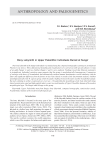
Bony labyrinth in Upper Paleolithic individuals buried at Sungir
Статья научная
The bony labyrinth of the Sungir individuals was studied using the computed tomography scanning on an industrial Phoenix X-ray device. Three-dimensional modeling and visualization were carried out with special software. Crania of an adult (Sungir 1) and two children (Sungir 2 and 3) were analyzed. Findings reveal that bilateral asymmetry is insignificant. Individual variation range suggests that the group is morphologically homogeneous. Comparison of averages with those of Neanderthals and anatomically modern humans demonstrates overall similarity with the latter and significant difference from the former in key traits. Based on results of the discriminant analysis, children unambiguously fall in the H. sapiens group, while the adult is halfway between the latter and the Neanderthal sample. But such a finding is neither exceptional nor even rare. A Neanderthal-like morphology of the bony labyrinth (large lateral semicircular canal and high sagittal index) occurs in a small number of Upper Paleolithic humans of the modern morphological type. The Sungir adult belongs to this group.
Бесплатно
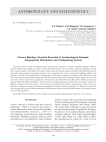
Статья научная
The study explores social and climatic factors affecting the occurrence of chronic maxillary sinusitis (CMS) in ancient and historical samples of Europe, North and South America, Asia, and Africa. The main database consists of 23 cranial samples. According to the results of univariate (correlation analysis and Wilcoxon-Mann-Whitney test) and multivariate (principal component) analyses, only climatic factors reveal a statistically significant effect on the frequency of CMS. The principal factor is temperature, which shows a negative correlation with CMS at the world level: the higher the mean annual temperature and the maximal temperature of the three hottest months, the lower the occurrence. At the regional level, significant correlation was also found between CMS and the number of rainy days per year. Rather than direct dependence, however, this result suggests that the correlation between climatic variables is different in Europe and North America. None of the socio-economic factors that we analyzed (sex, urban versus rural residence, subsistence strategy) demonstrated significant correlation with the prevalence of CMS at the world level. Assessing the effect of social status evaluated by archaeological criteria was impossible because of the complex nature of stress-inducing factors.
Бесплатно
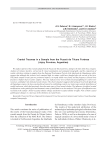
Cranial traumas in a sample from the Pucar'a de Tilcara fortress (Jujuy province, Argentina)
Статья
We analyze injuries in the cranial sample from the Pucará de Tilcara fortress, dating to the time of the Inca conquest. Analysis of violence markers, carried out by visual examination and computed tomography, and the comparison of results with those relating to samples from the Regional Development Period of the Quebrada de Humahuaca valley, suggest that although the violence level remained high, its nature could have changed after the arrival of the Inca. The female sample reveals just two perimortal injuries, no trophy skulls were found, and the frequency of nasal bone fractures is higher than in earlier samples. This may indicate lower level of between-group fi ghting for control over resources, and higher risk of interpersonal violence. The observed pattern suggests that having arrived in the Quebrada de Humahuaca region, the Inca eased political tension by establishing control over trade routes and the distribution of arable land areas, which had previously been the main cause of local armed clashes. The infl uence of artifi cial cranial modifi cations on the pathological and traumatic status of individuals was also analyzed. Two types of modifi cation were recorded in the sample—fronto-occipital tabular oblique and fronto-occipital tabular straight. None of them caused pathological changes or a decrease in the thickness of cranial bones.
Бесплатно
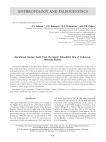
Deciduous human teeth from the Upper Paleolithic site of Yudinovo,Western Russia
Статья обзорная
Бесплатно

